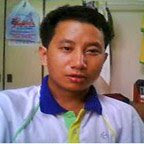
Yesterday, in the early morning, on Feb 26, Fr. Joseph Mclauglin, an American Marist missionary, ( my English teacher) came back home to the Sta Ana community in Davao city of the Philippines. Last November 2008, he went back to his own country for vocation.
During his three months vocation, most of the days, he stayed with his beloved 92-year-old mother who had recently been hospitalized in New Jersey, and his younger brother who has been suffering from down syndrome since his childhood. He visited his brothers and sisters who are living in different cities in the States. Besides, Fr. Joe had a talk with the students in the Marist high school in
Fr. Joe has choices to stay in the States and he can have the opportunity to stay closely with his ailing mother and brother, his close friends, and relatives. But, as a devotedly committed missionary, he came back to his Sta Ana community in the Philippine district and he dedicated his life to missions where he has been assigned and he lives with the poor people.
In fact, Fr. Joe, Joe for his friends and those who know him, came to the
His first ministry was in the gold mining areas in Diwalwal which is northern part of
He is now in charge of finances for the five Marist communities in the Philippine district. Also, he is in charge of the formation program for those who want to become Marists.



 Vice-major with some of my classmates
Vice-major with some of my classmates



